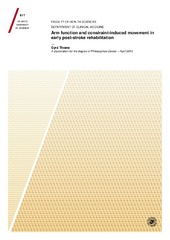| dc.contributor.advisor | Anke, Audny | |
| dc.contributor.author | Thrane, Gyrd | |
| dc.date.accessioned | 2015-10-15T08:07:20Z | |
| dc.date.available | 2015-10-15T08:07:20Z | |
| dc.date.issued | 2015-09-10 | |
| dc.description.abstract | Constraint-induced movement therapy (CIMT) is a treatment for mild-to-moderate upper extremity motor dysfunction in post-stroke patients. However, as the ideal time to initiate post-stroke treatment remains uncertain, more information is needed regarding the effects of CIMT and arm use in the early stages of stroke recovery. This thesis aimed to:
1) examine the correlations between arm motor impairment and real world arm use and its relationship with dependency in self-care activities in patients in the stroke unit. (Paper I)
2) assess the effects of modified CIMT applied within 28 days after stroke occurrence (Paper II)
3) review existing literature for the effects of CIMT on body function, activity, and participation in post-stroke patients (Paper III)
In Paper I, we found a high correlation between motor impairment and the patient’s actual use of the more affected arm. Further findings revealed that both the Fugl-Meyer motor assessment scores and arm use are related to dependency in self-care activities, but the finding might be confounded by lower extremity motor function. In Paper II, we found that CIMT initiated within 28 days after stroke occurrence was safe and feasible but did not improve long-term motor function. However, there was a significant effect on movement speed immediately after the treatment, and CIMT might promote a faster recovery compared to standard care. There were no differences between the groups with respect to reduced arm motor impairment or increased arm use. In the systematic review and meta-analysis conducted in Paper III, we found that CIMT can improve arm motor function and arm motor activities and may have a lasting effect on arm motor activity. The effects were especially stable in the sub-acute and chronic groups, and CIMT is therefore advocated for selected patients in these post-stroke stages.
Taken together, our study revealed that early CMIT has an immediate effect on timed measures of arm activity but does not improve long-term motor activity. The meta-analysis also showed uncertain effects of CIMT in the early post-stroke phase. This rehabilitative treatment should preferably be offered to patients in sub-acute and chronic stages after stroke. As learned nonuse might not be pronounced in the acute stage of stroke, the treatment should be aimed at preventing its development. | en_US |
| dc.description.doctoraltype | ph.d. | en_US |
| dc.description.popularabstract | Constraint induced movement therapy (CIMT) er en metode for å trene opp arm og håndfunksjon etter et hjerneslag. Metoden kjennetegnes ved 1) intensiv trening, 2) tiltak som fremme bruken av armen; og 3) bruk av en vott på den friske hånden. I avhandlingen undersøker Thrane først dokumentasjonen for at behandlingen virker ved å gjøre en systematisk litteraturgjennomgang med meta-analyse. Deretter undersøker han om CIMT virker i tidlig fase etter hjerneslag (<28 dager). En gruppe fikk 3 timers CIMT behandling pr. dag og brukte en vått på den beste armen. De ble sammenlignet med en kontrollgruppe som fikk vanlig behandling. Til sist undersøkte Thrane sammenhengen mellom bruk av den dårligste armen og motoriske utfall i tidlig fase etter hjerneslag. Det er god dokumentasjon for at CIMT virker dersom behandlingen gis 3 måneder eller mer etter hjerneslaget. I tidlig fase er imidlertid resultatet sprikende og CIMT bør gjennomføres med forsiktighet. Den kliniske studien viste at pasientene som fikk CIMT kunne gjøre aktiviteter med den den slagrammede armen raskere enn kontrollgruppen like etter behandlingen, men at disse forskjellene var utlignet etter 6 måneder. | en_US |
| dc.description.sponsorship | Helse Nord | en_US |
| dc.description | Paper II of this thesis is not available in Munin.<br>Efficacy of
constraint-induced movement therapy in early stroke rehabilitation: A randomized
controlled multisite trial. Thrane G, Askim A, Stock R, Indredavik B, Gjone R, Erichsen A, Anke A. <br>Available in <a href=http://dx.doi.org/10.1177/1545968314558599>Neurorehabilitation and Neural Repair, 2015, Jul;29(6)</a> | en_US |
| dc.identifier.uri | https://hdl.handle.net/10037/8208 | |
| dc.identifier.urn | URN:NBN:no-uit_munin_7796 | |
| dc.language.iso | eng | en_US |
| dc.publisher | UiT The Arctic University of Norway | en_US |
| dc.publisher | UiT Norges arktiske universitet | en_US |
| dc.rights.accessRights | openAccess | |
| dc.rights.holder | Copyright 2015 The Author(s) | |
| dc.rights.uri | https://creativecommons.org/licenses/by-nc-sa/3.0 | en_US |
| dc.rights | Attribution-NonCommercial-ShareAlike 3.0 Unported (CC BY-NC-SA 3.0) | en_US |
| dc.subject | constraint-indused movement therapy | en_US |
| dc.subject | stroke | en_US |
| dc.subject | rehabilitation | en_US |
| dc.subject | arm motor function | en_US |
| dc.subject | VDP::Medisinske Fag: 700::Helsefag: 800 | en_US |
| dc.subject | VDP::Medical disciplines: 700::Health sciences: 800 | en_US |
| dc.title | Arm function and constraint-induced movement in early post-stroke rehabilitation | en_US |
| dc.type | Doctoral thesis | en_US |
| dc.type | Doktorgradsavhandling | en_US |


 English
English norsk
norsk


